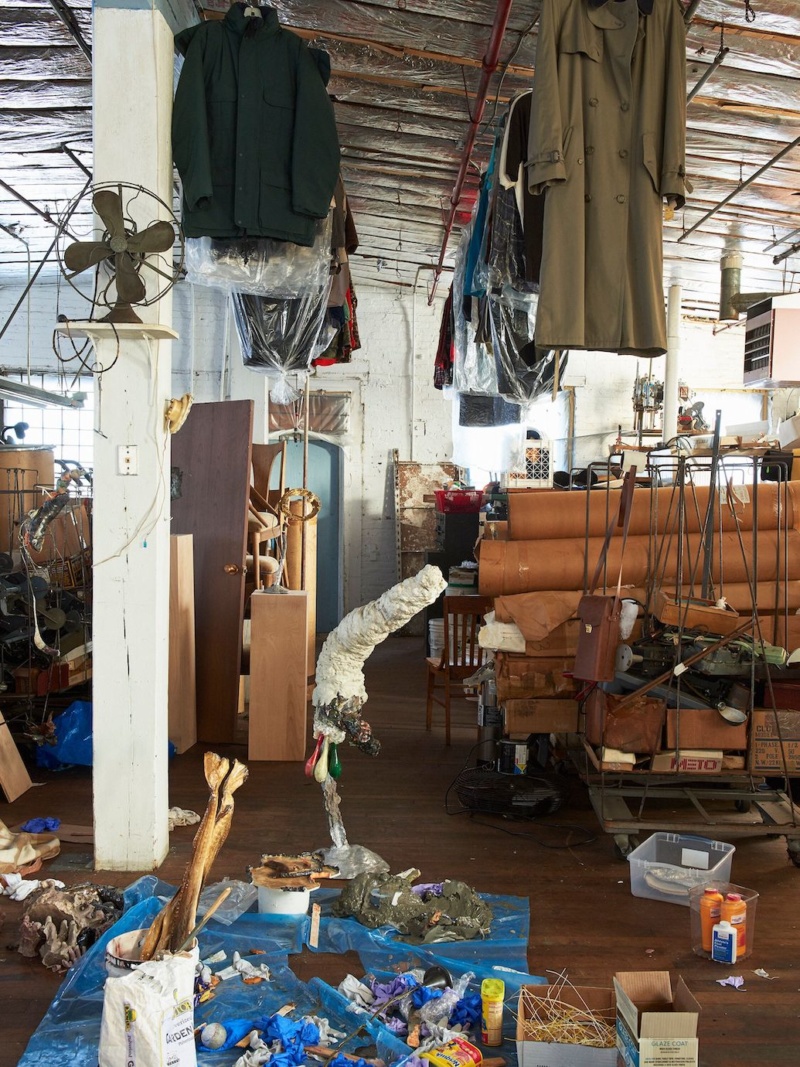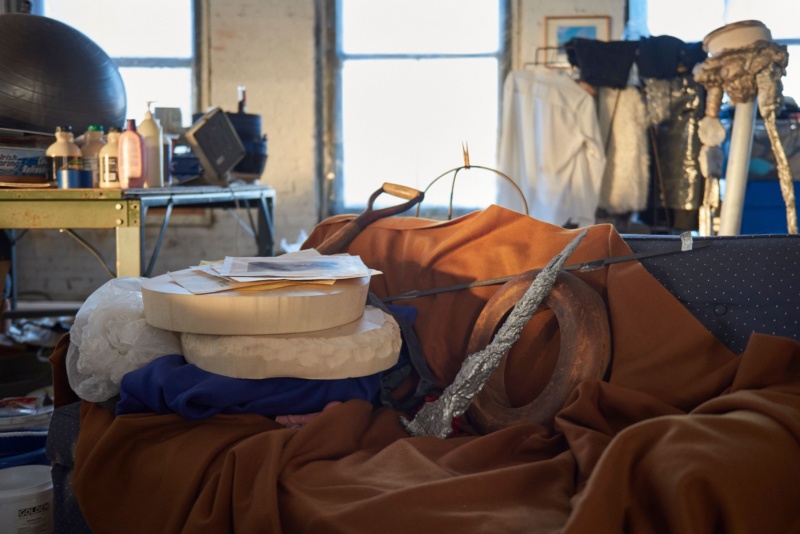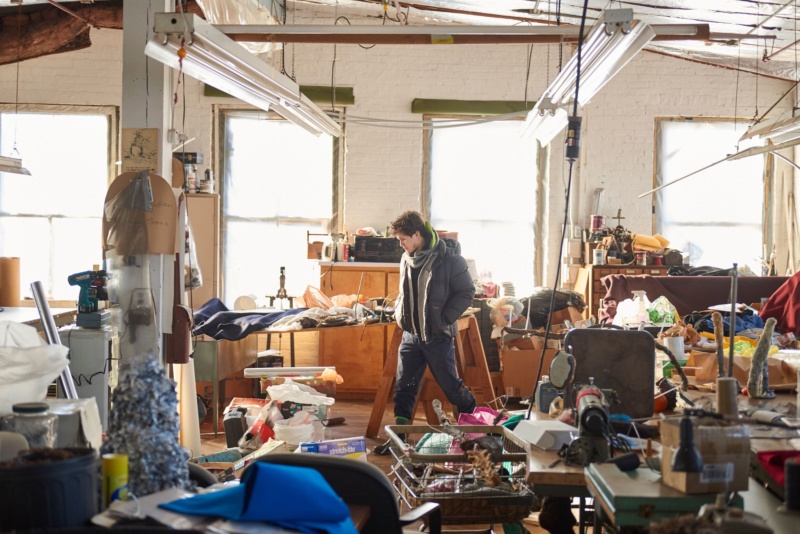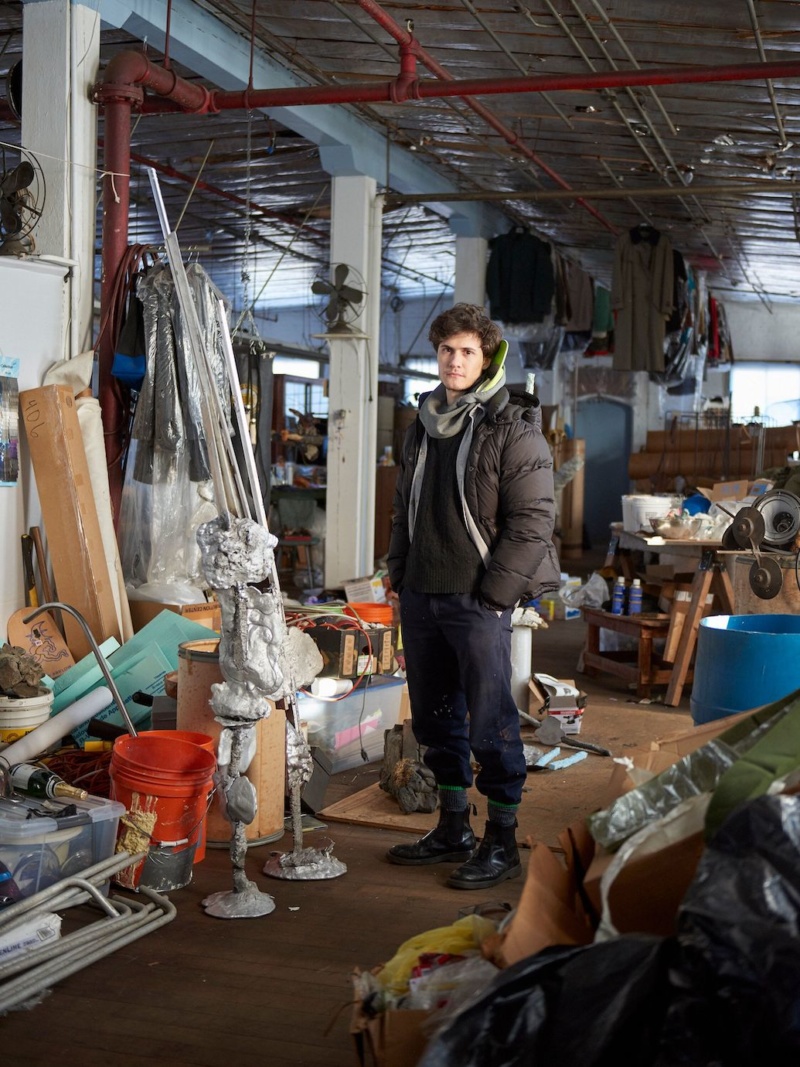
Artist Daniel Giordano’s sculptures tell multiple stories, so many stories they’ve become one, freaky, fragmented tale: the detritus of the Hudson River (so: the detritus of New Yorkers), preserved cheesecake crusts from his Italian aunt, deep-fried baseball bats, fizzy-sugared Orange Tang.
Based between New York City and Newburgh, Giordano goes on long walks to collect many of his materials, picking up what was once forgotten, and his studio is his family’s former coat factory, where he used to play and work. All this to say: Giordano daydreams about the past often, and finds ways to freeze it, cover it in glazed ceramic, make it look alive. His solo show, The Big Linguini, opened at Sardine in Bushwick, Brooklyn over the weekend; its press material is a story written by his brother, Anthony, loosely based on their grandfather. We caught up with Giordano about his work and inspiration; Kyle Knodell captured the sculptor in the studio, remnants of its former life still visible.
Can you tell me about the short story your brother, Anthony, wrote to accompany the show? The protagonist, Willis, is haunted, seemingly on the run. It’s full of images: wolves, the moon, a lumber mill, silver foreskins. My hope is for my brother to write more often, to be a writer. I think it is his passion. I see him as such. I wished to make a press release that was deeply personal and specific to me, my family, our warped Italian-American heritage, and our folklore. Something that hones your attention to the work in the show and brings a clarity to The Big Linguini. So, I prompted my brother, Anthony, to write a story about our baby foreskins that my mom saved.
As a child I would go hunting for items to play with in this designated tchotchke dresser drawer we had in my parents’ bedroom. I once stumbled upon what my mom would later explain were our foreskins, and I gazed at them with awe. The pieces of skin were tied around plastic rings set in a clasped container padded with cotton. Relics! I now see them as two of the things, among indelible experiences, that drive my production.

My brother took my requested prompt to write and wove it into a micro-biographical take on the myth of my grandfather, Willis, as retold to us by our mom: According to her, Willis escaped from his homeland, an unknown country about to be consumed by World War I, and found mill work in Canada. One day he was left behind by his crew, and was hunted by wolves through the night. Some time after making it through that fateful night, Willis left Canada and migrated south, settling in Miami where he built an automotive business, and raised a family. I never met Willis—unfortunately, he passed away before I was born—and little is known about him amongst his children, half of which, sadly, are also no longer with us. He rarely discussed his life, so I have heard.
How are the themes of The Big Linguini connected to the story—if at all? For me, the name of your exhibition evokes the nickname of some storied dude. Or maybe a strange fiasco. The Big Linguini is an omnipresent entity. A trickster, a person, an event, a dynamic, a situation, and an expression. The Big Linguini plays off SARDINE. My family folklore, my ridiculously embellished Italian-American upbringing and our family dynamics feed my work. My brother, in particular, is a major muse of mine.
You have an interesting approach to material; your sculptures look almost biomorphic/organic. How much are you informed by the materials you find—do you still use industrial detritus in your work? Orange Tang? Urinal cakes? I have a repertoire of materials and the list continuously expands. Something may dawn on me and make perfect sense. I absorb it, internalize it, and channel it in my work. Some materials and processes are more traditional and become a staple. The more unique materials converge with glazed ceramic, electro-plated objects, and cast aluminum. Together, I feel the work is elevated to a substantial state. The process of making is so pleasing. All the materials are considered.

My love of Barbarella's shag-carpeted spaceship interior (from the 1968 film, Barbarella) and my desire to give it a trim, my use of Tiger Balm from when I competed in international tennis tournaments, fabric and sewing machine parts left and forgotten in the factory, deep-fried batter in Italian cuisine and Billy the Beef Tallow Boy who taught me that I not only should use deep fried batter as a process and material but that you really can deep fry anything, my conditioned fear of Lyme and my inevitable Lyme-infected tick bite—I began using ticks. Of course, in addition to The Big Linguini, Orange Tang is also ubiquitous.
While in the studio, I work in a frenzy and I quite literally go into a kind of berserker mode. There are moments that require a soft delicate touch of the hand, but most of the time, I mirror something more like Charlie Chaplin in Modern Times. I usually only have a loose idea of each sculpture's overall form, but many are ruled by chance and circumstance. It's good not to treat anything as being too precious. No mercy or sympathy.

Both your brother’s story and your work recall for me the American wilderness, cowboys, stories about folks like Everett Ruess. What inspires you? Everything from the Etruscan chariot at the Met to the 1988 film Pumpkinhead and beyond inspires me. But more than anything, my upbringing and life in Newburgh, NY is my biggest influence. My cultural identity is rooted there. I have internalized it. I channel it into the work. I have a strong relationship with the Hudson River. I continue to walk its shore and collect from it. But isolation seems to be a consistency. I don't interact with most of Newburgh even to this day. I have a love and burning hatred for the place—specifically, my family's factory complex that was my playground as a child and which is now my studio. It was founded by my paternal grandfather, Frank. He named it the Vicki Clothing Company, after my Aunt Vicki. She is very important to me as well. For as long as I have known her, she has sported a relentlessly wonderful beehive hairdo. She can also bake a wicked cheesecake. I preserved one of her graham cracker crust cheesecakes; it resides in one of my sculptures.
My grandfather manufactured ladies’ coats at Vicki. My father, Tony, took Vicki over and continued to run it until 1996. The operation employed up to eighty workers when it was in full operation, including me from time to time. I remember handing out new pattern instructions to all the seamstresses on the second floor. Many of the people who worked there were immensely present in my young life—surrogate grandmothers showering me with gifts of Godzilla toys and Robocop figurines. Those who are still living, we continue to bond and share meals of pasta with red sauce.

How long have you been making art—were you a curious/creatively experimental child? I've made art most of my life, whether it was dumping an entire gallon of vinegar on the sofa and watching it shower onto the floor through the cushions or making sock puppets with drained eggs for eyes.
I always drew as a child. There are countless hours of practice. I was competitive with my brother in drawing and I remember trying to mimic his drawings of lizard-humanoid and shark-humanoid settlements and of their battle scenes. I always had a burning desire to make. I recall in high school I drew a potato that had growths on it. It resembled a hog. I shared the drawing with my tennis coach at the time; I really valued his direct and blunt opinions. He looked at the piece of paper with graphite all over it and then looked at me and said, “You’re really talented but you’re really fucked up.” Then I knew what I really had to do.



